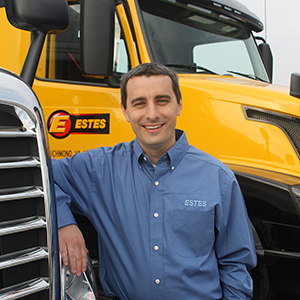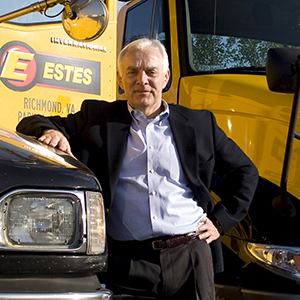The following story originally appeared as an Online Exclusive for the W&M Alumni Magazine. – Ed.
This past holiday season, headlines were full of stories about “supply-chain issues” and pundits warned consumers to start shopping early as certain items, especially imports, became harder to find or were subject to lengthy shipping delays. As demand for goods rose, it seemed global supplies and the companies that carried them to customers were grinding to a halt.
Rob Estes ’74, P ’06, president and CEO of Estes Express Lines, and his son Webb Estes ’06, M.Acc. ’07, vice president of process improvement, have an inside view of how goods move from place to place — and the challenges and opportunities the pandemic has brought to the freight transportation industry.

Their Richmond-based company, founded in 1931 by Rob’s grandfather, is one of the largest freight transportation providers in the U.S. Instead of slowing down during the pandemic, it generated more than $4.4 billion in revenue last year (up from $3.6 billion in 2020) and employs more than 22,000 people nationwide.
“COVID has changed how the world buys,” says Webb. “People couldn’t go to concerts and restaurants and didn’t want to shop in person, so they were buying more and more online. They wanted to do home improvement projects and fill their home offices. Demand was cut off for services but soared for products.”
Once products are purchased, Estes is one of the companies that helps transport them to consumers. Estes is the nation’s largest privately held less-than-truckload (LTL) freight carrier, meaning companies can add their products to an Estes truck with other companies’ products instead of purchasing an entire trailer of space.
The so-called “Amazon effect” — customers increasingly choosing to buy online, often from giants like Amazon — had already began before the pandemic. In May 2021, United Nations economists found that global e-commerce had jumped from 16% to 19% in 2020, reaching $26.7 trillion worldwide. This led to steady growth for Estes before the pandemic even began.
During the pandemic, the company’s growth increased by 30% in 2021. But issues they were facing before the pandemic have become more acute as it has continued.

“We’ve seen problems with getting containers unloaded and of enough freight going to warehouses, but the biggest issue is the number of drivers,” says Webb. “We have been in a shortage of drivers for many years now, which limits our speed and capacity. This is a very people-heavy industry.”
He and his father cite many factors, including older drivers retiring and younger people not pursuing trucking as a career. While 90% of Estes’ drivers return home every day, Webb says Estes faces a perception problem that truckers are frequently away from home or that the job is not enjoyable.
The American Trucking Association says the annual turnover rate in 2020 for large trucking companies was 92%. Less-than-truckload carriers like Estes averaged just 12% turnover. Still, Estes is now seeking 2,000 more drivers.
Current drivers can’t take on more hours, because the number of hours a trucker can drive per day is regulated by the government. So are requirements for getting a commercial driver’s license, or CDL. Applicants must be 21 years old or older to drive interstate, “so kids coming out of high school don’t see it as an option,” says Rob.
Estes runs its own school to help train more drivers, and about 250 people go through the course each year. The company encourages high-performing Estes employees from other departments, such as dock workers, to take the course, and it covers the full cost.
After Webb finished his Master of Accounting degree at William & Mary in 2007, he went through the Estes driving school to get his CDL while studying for his CPA exam.
“Getting the CDL was much harder!” he says, laughing. He displays his certificate from the driving school proudly on his office wall.
Despite the driver shortage, Estes has experienced strong growth, in part because of decisions Rob and Webb made when the pandemic was just starting. Other companies, expecting an economic slowdown, laid off workers. Debt-free and private, Estes avoided layoffs and was able to offer interest-free loans to employees. Webb calls being debt-free one of the most important parts of Rob’s legacy, noting that it is rare in the industry.
Almost 50% of Estes’ costs are people, and Rob and Webb say people are at the heart of all aspects of their business.
“A great team is not created during crisis; you either have it and you are successful or fall flat on your face,” says Rob. “There are always things you can’t prepare for, so make sure you have a good team around you that can help get through it.”
Estes’ leadership team also bought equipment from competitors when pricing was low. Now, with pricing at all-time highs, they are carefully considering how best to expand their fleet to keep up with demand.
While at the moment, keeping up with demand means running every truck in their fleet — even older, less efficient models — the Esteses hope they can further their efforts toward environmental sustainability in the future. They already use LED lights in their facilities and have installed solar panels, invested in electric forklifts and added skirts to their trailers to increase efficiency. They are looking at using more natural gas trucks.
“The future is in projects that are both green and green — good for business and the environment,” says Webb. Rob agrees: “The American economy just needs the right incentives to become more green.”
Estes is partnering with Remora and Amazon on a carbon-capture system for freight vehicles, with the pilot launching in September 2022.
“It is our responsibility to invest time and resources into tech that will help everybody. We can try creative ideas, and if 20% work, that’s well worth the time,” says Webb. “More startups are looking at transportation technology now than ever before.”
Information technology has been Webb’s responsibility at Estes for the past seven years. Of the 13 million shipments the company handled in 2021, 2 million were directly to houses — called “last-mile delivery.” Delivering to a residential address takes longer than delivering to a loading dock at a business, because drivers must find the location, navigate the driveway, often unload just one box from a full truck and then wait for the occupant to sign for it if needed.
Estes uses mapping to plan routes efficiently and load trailers in the correct order for the route. Drivers take a picture of the delivered package and text it to the customer, so 60% of their deliveries don’t need the customer to be home. And newer vehicles benefit from the same technology as consumer vehicles, such as lane assist and more efficient transmissions.
Once the pandemic is (finally) over, Rob and Webb expect growth to slow a little but that the last-mile industry will continue to be profitable. They are grateful for their William & Mary experiences that helped them get through this challenging time.
“Leadership is the hardest when a lot of change is happening, and leading during this time has taken my full attention. I am especially thankful for the support of my wife, Rose Merritt Estes ’07, whom I met at William & Mary,” says Webb. “I had so many leadership opportunities at William & Mary to try and to fail, and to practice being a servant leader. My faith grew at William & Mary, and it has been tested by this experience, so I’m thankful for the firm foundation.”
Rob agrees, saying William & Mary is responsible not only for him meeting his wife, Jean Berger Estes ’75, but also for launching lifelong friendships that helped shape who he is today. Both he and Webb received W&M accounting degrees, 31 years apart, so they both “think in numbers,” as Rob says.
Both are strong supporters of their alma mater. Rob served on the For the Bold Campaign Steering Committee, was co-chair of the Richmond Regional Campaign Committee, and served on the W&M Business School Foundation Board from 2004-2020. Most recently, he provided a generous gift for the W&M Athletics Complex. Webb also served on the Richmond committee and gives back to W&M.
Both continue to share their expertise with William & Mary students, and Webb was a guest lecturer in a supply chain class in the MBA program this past fall.
“I have a briefcase from the Mason School that Dean Larry Pulley ’75 gave me, and when people I meet with see it, they always have something good to say about William & Mary,” Webb says. “The respect people have for W&M in Virginia, in the U.S. and worldwide is incredible.”
Read more about Rob Estes in the Winter 2018 W&M Alumni Magazine feature “Richmond Revival.”






